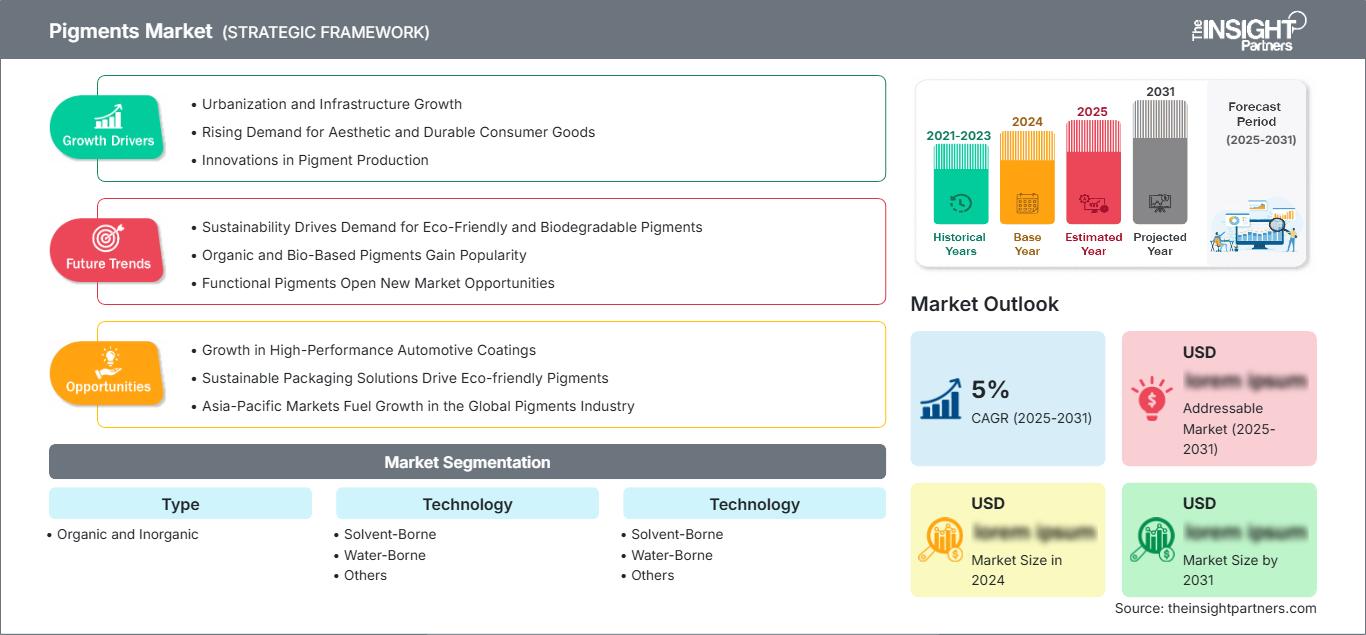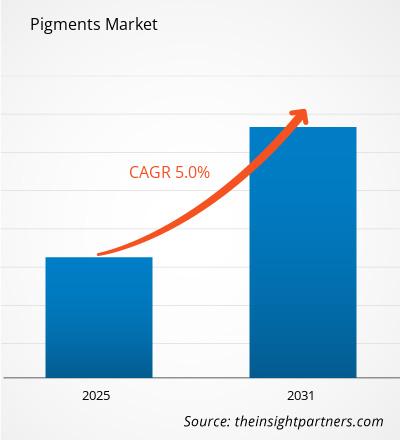Analystenperspektive
Der globale Pigmentmarkt wird voraussichtlich eine durchschnittliche jährliche Wachstumsrate (CAGR) von 4,2 % verzeichnen. Der Pigmentmarkt wird im Prognosezeitraum wachsen, angetrieben durch die steigende Nachfrage aus Schlüsselsektoren wie Farben, Kunststoffen und Druckfarben. Diese Branchen sind auf Pigmente angewiesen, um die Farbe und Haltbarkeit ihrer Produkte zu verbessern. Der Markt wird zusätzlich durch die steigende Beliebtheit organischer Pigmente beflügelt, die für ihre umweltfreundlichen und nachhaltigen Eigenschaften bekannt sind. Das Wachstum in Schwellenländern, die Nachfrage nach Hochleistungspigmenten und der Fokus auf Nachhaltigkeit sind bedeutende Wachstumschancen für den Pigmentmarkt. Die Entwicklung neuer Pigmentanwendungen, wie z. B. in Solarzellen und der Elektronik, schafft neue Chancen für den Markt. Umweltvorschriften, Rohstoffpreisvolatilität, Wettbewerb und technologische Umbrüche sind erhebliche Herausforderungen, die das Wachstum des Pigmentmarktes hemmen können.
Marktübersicht
Pigmente bestehen aus fein gemahlenen Feststoffpartikeln, die mit Öl, wasserbasierten Farben, Druckfarben und Kunststoffen vermischt werden. Sie verändern die Farbe von reflektiertem oder durchgelassenem Licht durch ihre selektive Absorption von Wellenlängen. Um andere Materialien effektiv einzufärben, müssen die Pigmente bestimmte Eigenschaften besitzen, darunter eine hohe Farbstärke im Verhältnis zu den gefärbten Materialien und Stabilität in fester Form bei einer Durchschnittstemperatur. Die wachsende Beliebtheit individuell eingefärbter Produkte treibt die Nachfrage nach einer breiteren Palette von Pigmenten. Die zunehmende Verwendung von Pigmenten in Kosmetika und Körperpflegeprodukten ist ein weiterer Treiber des Marktwachstums. Mit der zunehmenden Urbanisierung der Weltbevölkerung steigt der Bedarf an Wohnraum und anderer Infrastruktur, was zu einer erhöhten Bautätigkeit führt, die wiederum die Nachfrage nach Farben und Lacken und damit nach Pigmenten antreibt.
Markttreiber
- Pigmente sind ein wichtiger Bestandteil von Farben und Lacken, und die steigende Nachfrage nach diesen Produkten treibt das Wachstum des Pigmentmarktes. Die Bauindustrie ist ein wichtiger Treiber der Nachfrage nach Farben und Lacken, da neue Gebäude und Infrastrukturprojekte eine Vielzahl von Beschichtungen zum Schutz und aus ästhetischen Gründen benötigen.
- Die Automobilindustrie ist ein weiterer großer Verbraucher von Pigmenten. Pigmente werden in verschiedenen Automobilanwendungen eingesetzt, beispielsweise in Farben, Kunststoffen und Textilien. Die steigende Nachfrage nach Autos,
insbesondere in Entwicklungsländern, treibt das Wachstum des Pigmentmarktes voran.
Marktsegmentierung
Der globale Pigmentmarkt ist nach Typ, Technologie und Anwendung segmentiert. Der globale Pigmentmarkt ist nach Typ in organische und anorganische Pigmente segmentiert. Der Pigmentmarkt ist nach Technologie in lösemittelbasierte, wasserbasierte und sonstige Pigmente segmentiert. Je nach Anwendung ist er in Farben und Lacke, Kunststoffe, Textilien, Druckfarben, Leder, Bauwesen, Verpackung, Transport und sonstige segmentiert.
Regionale Analyse
Der Bericht bietet einen detaillierten Branchenüberblick, der qualitative und quantitative Informationen enthält. Er bietet Informationen zu einem Überblick und einer Prognose des globalen Pigmentmarktes basierend auf mehreren Segmenten. Es werden außerdem Marktgrößen- und Prognoseschätzungen für die Jahre 2021 bis 2031 für fünf Hauptregionen bereitgestellt: Europa, Nordamerika, Asien-Pazifik (APAC), Naher Osten und Afrika (MEA) sowie Süd- und Mittelamerika. Der Pigmentmarkt ist nach Regionen auch nach jeweiligen Ländern und Segmenten unterteilt. Der Pigmentmarktbericht umfasst eine Analyse und Prognose von 18 Ländern weltweit sowie die vorherrschenden Trends und Chancen in der Region.
Der Bericht analysiert Faktoren, die den Pigmentmarkt sowohl von der Nachfrage- als auch von der Angebotsseite her beeinflussen. Darüber hinaus bewertet er die Marktdynamik im Prognosezeitraum, d. h. treibende Kräfte, Herausforderungen, Chancen und zukünftige Trends. Der Bericht enthält auch eine umfassende Porter's Five Forces-Analyse, die Faktoren hervorhebt, die den Pigmentmarkt in diesen Regionen beeinflussen.
Hauptakteure
Die Berichte behandeln wichtige Entwicklungen organischer und anorganischer Wachstumsstrategien auf dem Pigmentmarkt. Verschiedene Unternehmen konzentrieren sich auf organische Wachstumsstrategien wie Produkteinführungen, Zulassungen, Patente und mehr. Zu den im Markt beobachteten anorganischen Wachstumsstrategien zählten Akquisitionen, Partnerschaften und Kooperationen. Diese Aktivitäten ebneten den Weg für die Entwicklung des Geschäfts und des Kundenstamms der Marktteilnehmer. Den Marktteilnehmern im Pigmentmarkt werden lukrative Wachstumschancen durch die steigende Nachfrage nach innovativen Produkten auf dem Weltmarkt erwartet. Der Bericht enthält Profile der wichtigsten Unternehmen, eine SWOT-Analyse und Marktstrategien für Pigmente. Der Bericht konzentriert sich außerdem auf führende Marktteilnehmer mit Informationen zu angebotenen Komponenten und Dienstleistungen, Unternehmensprofilen, Finanzinformationen der letzten drei Jahre und der entscheidenden Entwicklung der letzten fünf Jahre.
Nachfolgend finden Sie eine Liste der Unternehmen, die im globalen Pigmentmarkt tätig sind.
- AkzoNobel
- Clariant
- DIC CORPORATION
- The Chemours Company
- Venator Materials PLC
- Kronos Worldwide, Inc
- LANXESS
- ALTANA
- LB Group
- Pidilite Pigments
Sie erhalten kostenlos Anpassungen an jedem Bericht, einschließlich Teilen dieses Berichts oder einer Analyse auf Länderebene, eines Excel-Datenpakets sowie tolle Angebote und Rabatte für Start-ups und Universitäten.
Pigmentmarkt: Strategische Einblicke

-
Holen Sie sich die wichtigsten Markttrends aus diesem Bericht.Dieses KOSTENLOSE Beispiel umfasst Datenanalysen, die von Markttrends bis hin zu Schätzungen und Prognosen reichen.
Regionale Einblicke in den Pigmentmarkt
Die Analysten von The Insight Partners haben die regionalen Trends und Faktoren, die den Pigmentmarkt im Prognosezeitraum beeinflussen, ausführlich erläutert. In diesem Abschnitt werden auch die Marktsegmente und die geografische Lage in Nordamerika, Europa, dem asiatisch-pazifischen Raum, dem Nahen Osten und Afrika sowie Süd- und Mittelamerika erörtert.
Umfang des Pigmentmarktberichts
| Berichtsattribut | Einzelheiten |
|---|---|
| Marktgröße in 2024 | US$ XX million |
| Marktgröße nach 2031 | US$ XX Million |
| Globale CAGR (2025 - 2031) | 5% |
| Historische Daten | 2021-2023 |
| Prognosezeitraum | 2025-2031 |
| Abgedeckte Segmente |
By Typ
|
| Abgedeckte Regionen und Länder |
Nordamerika
|
| Marktführer und wichtige Unternehmensprofile |
|
Dichte der Akteure auf dem Pigmentmarkt: Verständnis ihrer Auswirkungen auf die Geschäftsdynamik
Der Pigmentmarkt wächst rasant, angetrieben durch die steigende Endverbrauchernachfrage aufgrund von Faktoren wie sich entwickelnden Verbraucherpräferenzen, technologischem Fortschritt und einem stärkeren Bewusstsein für die Produktvorteile. Mit steigender Nachfrage erweitern Unternehmen ihr Angebot, entwickeln Innovationen, um den Verbraucherbedürfnissen gerecht zu werden, und nutzen neue Trends, was das Marktwachstum weiter ankurbelt.

- Holen Sie sich die Pigmentmarkt Übersicht der wichtigsten Akteure
- Historische Analyse (2 Jahre), Basisjahr, Prognose (7 Jahre) mit CAGR
- PEST- und SWOT-Analyse
- Marktgröße Wert/Volumen – Global, Regional, Land
- Branchen- und Wettbewerbslandschaft
- Excel-Datensatz
Aktuelle Berichte
Erfahrungsberichte
Grund zum Kauf
- Fundierte Entscheidungsfindung
- Marktdynamik verstehen
- Wettbewerbsanalyse
- Kundeneinblicke
- Marktprognosen
- Risikominimierung
- Strategische Planung
- Investitionsbegründung
- Identifizierung neuer Märkte
- Verbesserung von Marketingstrategien
- Steigerung der Betriebseffizienz
- Anpassung an regulatorische Trends






















 Kostenlose Probe anfordern für - Pigmentmarkt
Kostenlose Probe anfordern für - Pigmentmarkt